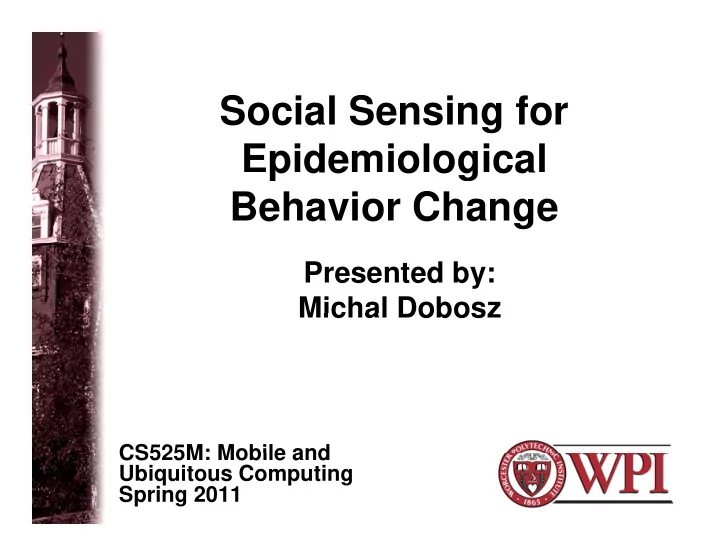

S Social Sensing for i l S i f Epidemiological p de o og ca Behavior Change Presented by: Michal Dobosz Michal Dobosz CS525M: Mobile and CS525M: Mobile and Ubiquitous Computing Spring 2011
Definition of Epidemiology Definition of Epidemiology • “Epidemiology is the study of Epidemiology is the study of patterns of health and illness and associated factors at the population associated factors at the population level.” – Outbreak investigation Outbreak investigation – Biology – Biostatistics Biostatistics – Social Science disciplines 2 2 Worcester Polytechnic Institute
Introduction Introduction • How is individual behavior affected How is individual behavior affected by illness and stress? • Measure characteristic behavior • Measure characteristic behavior change in symptomatic individuals – Mobile phone application M bil h li ti • Co-location • Communication • Communication • Predict health status of an individual 3 3 Worcester Polytechnic Institute
Benefits Benefits • Understanding how people behave Understanding how people behave when they are infected – Lack of realistic social interaction data Lack of realistic social interaction data and spatio-temporal data • Modeling can be made more accurate • Modeling can be made more accurate – Results can be used in the SIR model • Number and frequency of contacts on Number and frequency of contacts on Susceptible -> Infected transition – Face-to-face interaction in contagion Face to face interaction in contagion 4 4 process Worcester Polytechnic Institute
The Experiment The Experiment • Two months of data from an Two months of data from an undergraduate residence hall – Individuals surveyed daily for symptoms y y y p – Behavioral changes when individuals are sick • Total communication, communication patterns, network diversity, entropy of movement movement 5 5 Worcester Polytechnic Institute
Related Work Related Work • Mobile Phones as Social Sensors Mobile Phones as Social Sensors – Eagle and Pentland • Reality Mining – social network structure, y g and recognition of patterns in daily user activity – Gonzalez et. al Gonzalez et al • Call detail records used to characterize spatio-temporal regularity • Google Flu Trends 6 6 Worcester Polytechnic Institute
Related Work Cont. Related Work Cont. • Sociometric Sociometric Badge – Identify human y activity patterns and analyze con ersational conversational prosody features – Vocal features – Vocal features, body motion, relative location 7 7 Worcester Polytechnic Institute
Data Source Data Source • Undergraduate Dormitory Undergraduate Dormitory – 80% participated in the study, most of the remaining 20% were spatially isolated – Pro-technology orientation – Even distribution among academic years – 54% males and most were Engineering, Mathematics, and Science majors • Incentives – Windows Mobile Phones and $1 a survey 8 8 Worcester Polytechnic Institute
Data Sets Data Sets • Social Interaction Data from Mobile Social Interaction Data from Mobile Phones – Call data records – SMS logs – Bluetooth proximity and WLAN location p y sensing (every 6 minutes) • Symptom Data via Daily Self-Report y p y p – Physical and Emotional Symptoms – 20/69 participants FLU immunized p p 9 9 Worcester Polytechnic Institute
Survey Questions Survey Questions • Do you have a sore throat or cough? y g • Do you have a runny nose, congestion or sneezing? • Do you have a fever? • Have you had any vomiting, nausea or diarrhea? diarrhea? • Have you been feeling sad, lonely or depressed p • lately? • Have you been feeling stressed out lately? y g y 10 10 Worcester Polytechnic Institute
Survey Data Survey Data • Immunized Participants not Immunized Participants not considered • Survey Data Survey Data – 63% survey completion rate – Grouped into 48-hour periods Grouped into 48 hour periods – Symptoms labeled as FLU by medically trained epidemiologist p g • 12 cases identified, lasting 5-7 days 11 11 Worcester Polytechnic Institute
Sensor Data Sensor Data • Total Communication – Phone Calls and SMS • Communication (10PM – 9AM on weekdays) • Communication Diversity • Physical Bluetooth Proximity day and night (10PM – 9AM on weekdays) • Physical Bluetooth Proximity excluding students t d t • University WLANs and non-University WLANs WLANs 12 12 Worcester Polytechnic Institute
Behavioral Effects of Low Intensity Symptoms (Runny y p ( y Nose, Sore Throat and Cough) 13 13 Worcester Polytechnic Institute
Behavior Effects of Higher-Intensity Symptoms (Fever and Influenza) Symptoms (Fever and Influenza) 14 14 Worcester Polytechnic Institute
Behavior Effects of Fever Behavior Effects of Fever 15 15 Worcester Polytechnic Institute
Behavior effects of CDC- d fi defined influenza d i fl 16 16 Worcester Polytechnic Institute
Symptom Classification Using B h Behavioral Features i l F t • Cell phones can predict illness p p • K-nearest-neighbor-clustering – stress + depression p – runny nose + sore throat – fever + influenza – runny nose + sore throat + fever + influenza • Bayesian-network classifier with MetaCost – Accuracy between 60% - 80% 17 17 Worcester Polytechnic Institute
Temporal Flux Between Behavior, St Stress and Physical Symptoms d Ph i l S t • Granger causality Granger causality test – Poor noise immunity • Phase Slope p Index (PSI) Method 18 18 Worcester Polytechnic Institute
Conclusions Conclusions • Limitations Limitations – Bluetooth signal strength – Statistical tests assume independent Statistical tests assume independent samples • Doctors and nurses can use diagnostic information – Early detection of conditions y – Better healthcare – Lower costs 19 19 Worcester Polytechnic Institute
References References • Social Sensing for Epidemiological g p g Behavior Change, Anmol Madan, Manuel Cebrian, David Lazert and Alex Pentland, MIT Media Lab and Harvard University, MIT Media Lab and Harvard University Cambridge MA • http://hd media mit edu/badges/ • http://hd.media.mit.edu/badges/ • http://www.google.org/flutrends/ • http://en wikipedia org/wiki/Epidemiology • http://en.wikipedia.org/wiki/Epidemiology 20 20 Worcester Polytechnic Institute
Recommend
More recommend